Economy of Serbia
 New Belgrade, financial center of Serbia. | |
| Currency | Serbian dinar (RSD) |
|---|---|
| Calendar year | |
Trade organisations | CEFTA, BSEC |
| Statistics | |
| GDP |
|
| GDP rank | 84th (nominal) / 79th (PPP) |
GDP growth |
|
GDP per capita |
|
GDP by sector |
services: 51.1% industry: 38.5% agriculture: 10.4% (2015 est.)[3] |
|
| |
Population below poverty line | 9.2% (2014)[3] |
| 38.7 (2014)[3] | |
Labour force | 2.9 million (2015 est.)[3] |
Labour force by occupation |
services: 62.5% agriculture: 21.9% industry: 15.6% (2014 est.)[3] |
| Unemployment |
|
Average gross salary |
$612 monthly (April 2016) |
|
$447 monthly (April 2016) | |
Main industries | motor vehicle, base metals, furniture, food processing, machinery, chemicals, sugar, tires, clothes, pharmaceuticals |
|
| |
| External | |
| Exports |
|
Export goods | motor vehicles ($2.054bn), electrical machines ($1.164bn), cereals ($0.786bn), fruit and vegetables ($0.748bn), and clothes ($0.629bn) (2014)[7] |
Main export partners |
|
| Imports |
|
Import goods | motor vehicles ($2.163bn), oil ($1.808bn), electrical machines ($0.813bn), natural gas ($0.807bn), medical products ($0.700bn) |
Main import partners |
|
FDI stock | $29.8 billion (From 2000-2013)[8] |
Gross external debt |
|
| Public finances | |
| 71.5% of GDP (April 2016 est.)[3] | |
|
$1.4 bn (2015)[3] 3.7% of GDP[9] | |
| Revenues | $14.91 bn (2015 est.)[3] |
| Expenses | $16.40 bn (2015 est.)[3] |
| Economic aid | $3.49 billion of EU IPA funding (2001–2014)[10] |
Foreign reserves | $11.68 billion (December 2015)[3] |
| Economy of Serbia |
|---|
 |
| Overview |
| Serbia topics |
|
Economy of Serbia is the 84th or 79th largest in the world at $43.866 billion or $95.492 billion by nominal gross domestic product or purchasing power parity respectively. Its economy is mostly based on various services (51.1% of GDP), industry (38.5% of GDP) and agriculture (10.4% of GDP).[3] In the late 1980s, at the beginning of the process of economic transition from a planned economy to a market economy, Serbia's economy had a favorable position, but it was gravely impacted by economic sanctions from 1992 to 1995.[14]
After the ousting of former Yugoslav President Slobodan Milošević in October 2000, the country went through an economic liberalization process, and experienced fast economic growth. GDP per capita (nominal) went from $1,241 in 2000 to $6,123 in 2014.[15] Furthermore, it became a candidate for the European Union in March 2012. The European Union is Serbia's most important trading partner. After years of economy decline due to world financial crisis, in 2011, the economy GDP growth was 2%.[16] Serbia entered a second recession in 2012, causing GDP to decline 1.5% for that year. In 2013, Serbia was among the top ten of European countries in regard to GDP growth, which amounted to 2.6% year on year.[17] As of 2016 estimations, the unemployment rate was at 19.3%.[3] Estimated GDP (nominal) for 2016 calendar year is $43.866 billion, which is $6,123 per capita, while the estimated GDP (PPP) is $100.18 billion, which is $14,047 per capita.[15] Since the 1990s, Serbia has experienced a serious "brain drain", especially during the wars at that time;[18] each year, more than 32,000 people emigrate.[19] Despite the loss, the Serbian diaspora's transfers account between 10% and 15% of Serbia's GDP and significantly increase living standards in some parts of the country.[20]
In recent years, Serbia has seen an increasingly swift foreign direct investment trend, including auto industry (Fiat), metal processing (US Steel), building materials (Lafarge), food and beverages (Carlsberg, Coca Cola, and Nestle), textiles (Golden Lady, Pompea), leather (Progetti Company, Falc East), and ICT (Microsoft and Siemens).[21] By countries, most cash investments in the 2000–2012 period came from Italy ($2.69 billion), Austria ($2.65 billion), Norway ($2.16 billion), Belgium ($2.00 billion) and Greece ($1.66 billion), while other major investor countries also include United States, Russia, and Germany.[22] The actual amount of investments from countries such as the United States and Israel is significantly higher than the official figure due to their companies investing primarily through European affiliates.[23]
Overview
Macroeconomic trends
The average growth of Serbia's GDP in the last ten years was 2.45% per year. GDP structure by sector in 2015 was: services 51.1%, industry 38.5%, agriculture 10.4%.[3] GDP structure by components in 2015 was: private consumption 81.0%, public consumption 17.9%, fixed capital investments 17.8%, inventories investments -10.1%, exports 46.0%, imports -52.6%.[3]
The following table shows the GDP flow since 2000:[24]
| Year | GDP (USD bn) | GDP growth rate | GDP per capita (Nominal) | GDP per capita (PPP) | Unemployment rate |
|---|---|---|---|---|---|
| 1997 | n/a | n/a | n/a | n/a | 12.3 |
| 1998 | n/a | n/a | 2,039 | n/a | 12.8 |
| 1999 | n/a | -11.2 | 1,444 | n/a | 13.3 |
| 2000 | 8.66 | +5.3 | 1,152 | 6,233 | 12.1 |
| 2001 | 11.43 | +5.3 | 1,524 | 6,725 | 12.2 |
| 2002 | 15.16 | +4.3 | 2,021 | 7,128 | 14.5 |
| 2003 | 19.58 | +2.5 | 2,617 | 7,472 | 16.0 |
| 2004 | 23.54 | +9.3 | 3,154 | 8,413 | 19.5 |
| 2005 | 25.06 | +5.4 | 3,368 | 9,181 | 21.8 |
| 2006 | 29.33 | +3.6 | 3,957 | 9,838 | 21.6 |
| 2007 | 39.16 | +5.4 | 5,304 | 10,687 | 18.8 |
| 2008 | 47.67 | +3.8 | 6,485 | 11,361 | 14.7 |
| 2009 | 40.24 | -3.5 | 5,497 | 11,090 | 17.4 |
| 2010 | 36.38 | +1.0 | 5,030 | 11,385 | 20.0 |
| 2011 | 43.77 | +1.6 | 6,030 | 11,854 | 24.4 |
| 2012 | 38.09 | -1.5 | 5,291 | 11,982 | 23.1 |
| 2013 | 42.49 | +2.6 | 5,902 | 12,465 | 21.0 |
| 2014 | 42.65 | -0.6 | 5,924 | 12,605 | 21.6 |
Serbia's primary industries include processing of motor vehicles, base metals, furniture, food processing, machinery, chemicals, sugar, tires, clothes and pharmaceuticals.[3] The main export products of Serbia in 2013 were: motor vehicles ($2.18bn), electrical machines ($1.12bn), fruit and vegetables ($0.67bn), cereals ($0.66bn) and non-ferrous metals ($0.65bn).[7] The main Serbian agriculture products are wheat, maize, sunflower, sugar beets, fruits (raspberries, apples, sour cherries), vegetables (tomatoes, peppers, potatoes), beef, pork, and meat products, milk and dairy products, grapes/wine.[3] Agriculture accounts for 8.2% of Serbia's GDP and almost one fourth of the country's total exports, with around 23.9% of the population working in the industry.[25] The average growth of Serbian industry total from 2000 to 2013 was 1.51% per year.[26]
| Industrial production growth rate | ||||||||||||||
|---|---|---|---|---|---|---|---|---|---|---|---|---|---|---|
| Year | 2000 | 2001 | 2002 | 2003 | 2004 | 2005 | 2006 | 2007 | 2008 | 2009 | 2010 | 2011 | 2012 | 2013 |
| Mining and quarrying | 28.8 | -21.1 | 14.4 | -0.8 | -1.5 | 2.8 | 1.4 | -4.1 | 4.2 | -7.9 | 18.1 | -3.4 | -12.6 | 7.5 |
| Manufacturing | 44.7 | -13.8 | 2.0 | -7.3 | 14.2 | -10.3 | 6.1 | -1.1 | -3.5 | -16.6 | 19.7 | -4.3 | -1.4 | 6.6 |
| Electricity, gas and water supply | 8.7 | -0.9 | -2.9 | 4.0 | -2.4 | 6.7 | -4.4 | 0.6 | -1.0 | -1.2 | -4.9 | 14.2 | -16.8 | 15.2 |
| Industry total | 27.0 | -11.3 | 1.7 | -4.8 | 10.1 | -6.3 | 3.9 | -1.0 | -2.6 | -13.2 | 15 | -0.8 | -5 | 8.4 |
| Source:[27] | ||||||||||||||
Public finances
The Serbian Ministry of Finance performs tasks related to the state budget, public revenue, public spending and public debt in the country. Serbia's public debt relative to GDP from 2000 to 2008 decreased by 140.1 percentage points, and then started increasing again as the government was fighting effects of world-wide 2008 financial crisis.
| Public debt | |||||||||||||||||
|---|---|---|---|---|---|---|---|---|---|---|---|---|---|---|---|---|---|
| Year | 2000 | 2001 | 2002 | 2003 | 2004 | 2005 | 2006 | 2007 | 2008 | 2009 | 2010 | 2011 | 2012 | 2013 | 2014 | 2015 | |
| Debt (Billion EUR) | 14.17 | 13.43 | 11.53 | 11.02 | 9.68 | 10.28 | 9.35 | 8,88 | 8.78 | 9.85 | 12.16 | 14.78 | 17.72 | 20.14 | 22.76 | 24.81 | |
| Debt (Percent of GDP) | 201.2% | 97.7% | 68.3% | 61.7% | 52.6% | 50.2% | 35.9% | 29.9% | 28.3% | 32.8% | 41.8% | 45.4% | 56.2% | 59.6% | 70.4% | 76.0% | |
| Source: Ministry of Finance of Serbia | |||||||||||||||||
The National Bank of Serbia is the central bank of Serbia and as such its main responsibilities are the protection of price stability, the dinar exchange rate policy, management of the foreign currency reserves and maintenance of efficient payment and financial systems. Serbian foreign exchange reserves were highly augmented from 2000 to 2007, when they amounted 10.86 billion euros. As of 2013, Serbia's budget deficit is 4.88% and the public debt is 63.8% of GDP.[28]
| Foreign exchange reserves | ||||||||||||||
|---|---|---|---|---|---|---|---|---|---|---|---|---|---|---|
| Year | 2000 | 2001 | 2002 | 2003 | 2004 | 2005 | 2006 | 2007 | 2008 | 2009 | 2010 | 2011 | 2012 | 2013 |
| National bank (Billion EUR) | 0.55 | 1.32 | 2,19 | 2.84 | 3.10 | 4.92 | 9.02 | 9.63 | 8.16 | 10.60 | 10.00 | 12.06 | 10.91 | 11.19 |
| Domestic banks (Billion EUR) | 0.39 | 0.72 | 0.68 | 0.67 | 0.59 | 0.55 | 0.52 | 1.22 | 0.92 | 1.42 | 1.68 | 0.80 | 1.06 | 0.91 |
| Total (Billion EUR) | 0.95 | 2.05 | 2.86 | 3.50 | 3.70 | 5.47 | 9.54 | 10.86 | 9.08 | 12.03 | 11.69 | 12.87 | 11.97 | 12.10 |
| Source: National Bank of Serbia | ||||||||||||||
External trade
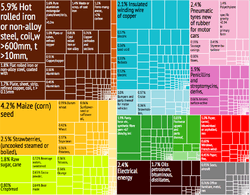
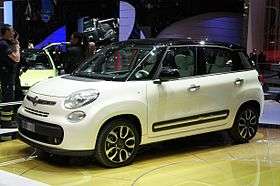
Serbia signed Free Trade Agreement (FTA) with the EU enabling exports of all products originating from Serbia without customs and other fees.[29] For a limited number of products (baby beef, sugar, and wine), annual import quotas remain in effect. As of 2013, the EU countries were the largest partners of Serbia in terms of export with the value of $8.810 billion (60.30%) and in terms of import with the value of $13.348 billion (64.99%) of Serbia.[30] The value of bilateral trade between Serbia and the EU largest economy Germany reached a total of $3.73 billion in 2013, a historical record for the two nations.[31]
Serbia signed the CEFTA enabling exports of all products originating from Serbia without customs and other fees in the region: Albania, Bosnia and Herzegovina, Macedonia, Moldova, Montenegro and Kosovo.[29] In 2014, the CEFTA countries were the second largest trading partners of Serbia with sufficiency of $1.895 billion.[7]
Serbia FTA with Russia was implemented since 2000, with further liberalizations in 2009 and 2011.[29] For a limited number of products, annual import quotas remain in effect. The list of products, excluded from the Free Trade Agreement with Russia, is revised annually. The CIS countries (Russia is a participating country of CIS) are also large trading partners of Serbia.[29][32]
Serbia signed a FTA with EFTA members in December 2009.[33] With Switzerland and Liechtenstein it is active as of 2010 and with Norway and Iceland as of 2011. FTA with Turkey was signed in 2009, but took effect in May 2010.[32] Trade with the U.S. is pursued under the Generalized System of Preferences (GSP). U.S. trade benefits provide for a preferential duty-free entry for app. 4,650 products.[34]
| External trade | ||||||||||||||||||
|---|---|---|---|---|---|---|---|---|---|---|---|---|---|---|---|---|---|---|
| Year | 2002 | 2003 | 2004 | 2005 | 2006 | 2007 | 2008 | 2009 | 2010 | 2011 | 2012 | 2013 | 2014 | 2015 | ||||
| Exports (mil. USD): | 2,074 | 2,756 | 3,523 | 4,480 | 6,431 | 8,823 | 10,974 | 8,345 | 9,794 | 11,780 | 11,353 | 14,614 | 14,843 | 13,379 | ||||
| Imports (mil. USD): | 5,614 | 7,477 | 10,755 | 10,461 | 13,174 | 19,165 | 24,332 | 15,808 | 16,471 | 19,862 | 19,014 | 20,543 | 20,650 | 18,218 | ||||
| Trade Balance (mil. USD): | -3,540 | -4,721 | -7,232 | -5,981 | -6,743 | -10,342 | -13,358 | -7,463 | -6,677 | -8,082 | -7,661 | -5,929 | -5,806 | -4,839 | ||||
| Exports/Imports (%): | 36.9 | 36.9 | 32.8 | 42.1 | 48.8 | 46.0 | 45.1 | 52.8 | 59.5 | 59.3 | 59.7 | 71.1 | 71.9 | 73.4 | ||||
Source: Statistical Office of Serbia
| ||||||||||||||||||
Foreign direct investments
|
Leading investor nations in Serbia as of 2013: |
Serbia is open to foreign direct investment, and attracting FDI is set as a priority for the government of Serbia, which provides both financial and tax incentives to companies willing to invest.[35] Serbia has a long history of international commerce, even under communism, and it once attracted a sizeable foreign company presence, mainly due to its access to Comecon, and Non-Aligned Movement markets. Today, leading investor nations in Serbia include: Italy ($2.69bn), Austria ($2.65bn), Norway ($2.16bn), Belgium ($2.00bn) and Greece ($1.66n).[22] In a recent poll for investors, conducted by the German Chamber of Commerce, Serbia came on top as an investment destination in South-Eastern Europe, with 97% of companies being pleased with business conditions.[36] A total of $1.52 billion of foreign direct investment was received in 2013.[8]
| Foreign direct investments | ||||||||||||||
|---|---|---|---|---|---|---|---|---|---|---|---|---|---|---|
| Year | 2000 | 2001 | 2002 | 2003 | 2004 | 2005 | 2006 | 2007 | 2008 | 2009 | 2010 | 2011 | 2012 | 2013 |
| Inward FDI (USD Billions) | 0.054 | 0.177 | 0.546 | 1.511 | 1.077 | 1.579 | 5.663 | 4.389 | 3.407 | 2.729 | 1.549 | 3.018 | 2.629 | 1.518 |
| Total per capita (USD) | 7.2 | 23.6 | 72.8 | 202.0 | 144.3 | 212.2 | 764.0 | 594.6 | 461.5 | 372.8 | 212.5 | 415.8 | 365.2 | 211.9 |
| Source:[8] Inward FDI by Industries (2004–2013):
| ||||||||||||||
Blue-chip corporations making investments in Serbia include: US Steel, Philip Morris, Microsoft, Fiat, Coca-Cola, Lafarge, Siemens, Carlsberg and others.[21] In the energy sector, Russian energy giants, Lukoil and Gazprom have made large investments.[37] The banking sector has attracted investments from Banca Intesa (Italy), Crédit Agricole and Société Générale (France), HVB Bank (Germany), Erste Bank, Raiffeisen Zentralbank and Addiko Bank (Austria), Eurobank EFG, Piraeus Bank (Greece), and others.[38] United States based Citibank, opened a representative office in Belgrade in December 2006.[39] In the trade sector, biggest foreign investors are France's Intermarché, German Metro Cash and Carry, Greek Veropoulos, and Slovenian Mercator.
Although most investments in previous years came primarily from the EU, greater interest is being shown from countries like India and Russia. On September 25, 2007, the Government of Serbia and Indian firm Embassy Group signed a memorandum of understanding on information technology park construction.[40] Embassy Group plans to build their first technological park in Europe at an area of 280ha in the town of Inđija near Belgrade. The five-year plan predicts building a business area of 250,000 square meters and employing around 25,000 people. This is planned as the largest Greenfield investment in Serbia, accounting for a minimum of $600 million.[41] On December 24, 2008, presidents of Serbia and Russia, Boris Tadić and Dmitry Medvedev have signed oil and natural gas deal under which Gazprom's oil arm Gazprom Neft gets a 51% stake in state-owned Naftna Industrija Srbije for 400 million euros in cash and 550 million euros in investments. There are also several architectural projects in Belgrade with foreign investment.
Domestic currency
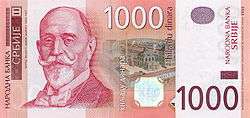
The official currency in Serbia is the Serbian dinar - RSD (1 dinar is lowest unit), RSD = 0.00827 Euro = 0.01005 USD (12/31/2014 National Bank of Serbia exchange rate).
| Exchange rates | ||||||||||||||
|---|---|---|---|---|---|---|---|---|---|---|---|---|---|---|
| Year | 2002 | 2003 | 2004 | 2005 | 2006 | 2007 | 2008 | 2009 | 2010 | 2011 | 2012 | 2013 | 2014 | |
| USD/RSD | 58.98 | 54.64 | 57.94 | 72.22 | 59.98 | 53.73 | 62.90 | 66.73 | 79.28 | 80.87 | 86.18 | 83.13 | 99.46 | |
| EUR/RSD | 61.51 | 68.31 | 78.89 | 85.50 | 79.00 | 79.24 | 88.60 | 95.89 | 105.50 | 104.64 | 113.72 | 114.64 | 120.96 | |
| Source: National Bank of Serbia; Note: All data retrieved each year on December 31 | ||||||||||||||
Companies
The list includes ten largest Serbian companies by revenue in 2013 (excluding banks):[42]
| Rank | Company | Headquarters | Industry | Revenue (Mil. €) | Employees | Note | |
|---|---|---|---|---|---|---|---|
| 1. | Naftna Industrija Srbije | |
Novi Sad | Petroleum | 2,307 | 7,629 | [43] |
| 2. | Elektroprivreda Srbije | |
Belgrade | Electric utility | 1,917 | 31,569 | [44] |
| 3. | Fiat Automobili Srbija | |
Kragujevac | Automotive | 1,497 | 3,668 | [45] |
| 4. | Telekom Srbija | |
Belgrade | Telecommunications | 1,018 | 13,229 | [46] |
| 5. | Delhaize Srbija | |
Belgrade | Retail | 886 | 11,763 | [47] |
| 6. | Srbijagas | |
Novi Sad | Natural gas | 602 | 3,011 | [48] |
| 7. | Tarkett | |
Bačka Palanka | Manufacturing | 562 | 2,755 | [49] |
| 8. | Mercator-S | |
Novi Sad | Retail | 553 | 4,701 | [50] |
| 9. | IDEA | |
Belgrade | Retail | 483 | 3,954 | [51] |
| 10. | Delta Holding | |
Belgrade | Holding | 481 | 3,417 | [52] |
Agriculture
Agriculture in Serbia is still an important section of Serbian economy with an annual potential of EUR 12 billion in exports.[53] Serbia has very favourable natural conditions (land and climate) for varied agricultural production. It has 5,056,000 ha of agricultural land (0.7 ha per capita), out of which 3,294,000 ha is arable land (0.45 ha per capita).[54] In 2013, Serbia exported agricultural and food products worth $2.8 billion, and the export-import ratio was 180%.[55] Agricultural exports constitute one-fifth of all Serbia's sales on the world market. Serbia is one of the largest provider of frozen fruit to the EU (largest to the French market, and 2nd largest to the German market).[56] Agricultural production is most prominent in Vojvodina on the fertile Pannonian Plain. Other agricultural regions include Mačva, Pomoravlje, Tamnava, Rasina, and Jablanica.[57] In the structure of the agricultural production 70% is from the crop field production, and 30% is from the livestock production.[57] Serbia is world's second largest producer of plums (582,485 tons; second to China), second largest of raspberries (89,602 tons, second to Poland), it is also significant producer of maize (6.48 million tons, ranked 32nd in the world) and wheat (2.07 million tons, ranked 35th in the world).[58][59] Other important agricultural products are: sunflower, sugar beet, soybean, potato, apple, pork meat, beef, poultry and dairy.
There are 56,000 ha of vineyards in Serbia, producing about 230 million litres of wine annually.[54][58] Most famous viticulture regions are located in Vojvodina and Šumadija.
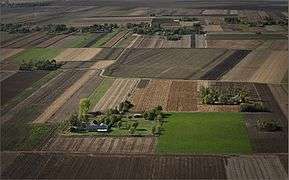 Over 60% of Serbia is arable land
Over 60% of Serbia is arable land Serbia is the world's second largest exporter of raspberries
Serbia is the world's second largest exporter of raspberries
Energy
Serbia has abundance of one natural fuel (coal) and relatively significant but not sufficient of the others (oil and gas). Serbia's proven reserves of 5.5 billion tons of coal lignite are 5th largest in the world (second in Europe, after Germany. Coal is found in two large deposits: Kolubara (4 billion tons of reserves) and Kostolac (1.5 billion tons) Despite being small on a world scale, Serbia's oil and gas resources (77.4 million tons of oil equivalent and 48.1 billion cubic meters, respectively) have a certain regional importance since they are largest in the region of former Yugoslavia as well as the Balkans (excluding Romania) Almost 90% of the discovered oil and gas are to be found in Banat and those oil and gas fields are by size among the largest in the Pannonian basin but the average on a European scale.The current oil production in Serbia amounts to over 1.1 million tons of oil equivalen, and satisfies some 43% of country's needs while the rest is imported.
Electricity The main producer of electricity in Serbia is Elektroprivreda Srbije. The company has an installed capacity of 8,359 MW and generates 38.9 TWh of electricity per year. Its installed capacity in lignite-fired thermal power plant is 5,171 MW, gas-fired and liquid fuel-fired combined heat and power plants is 353 MW, and hydro power plants is 2,835 MW.[60] EPS is also the largest producer of lignite in Serbia operating in the Kolubara and Kostolac basins, producing around 37 million tonnes per year.[61]
Oil and Natural Gas Naftna Industrija Srbije is the only company in Serbia which deals with exploration and production of crude oil and gas, as well as with production of geothermal energy.[62] The company disposes with all necessary equipment for the performance of a whole range of complex activities such as geophysical exploration, control of production of crude oil, gas and geothermal energy. The majority of NIS oil fields are located on the territory of Serbia, in the province of Vojvodina, but upstream has business operations both in Serbia and abroad. In 2011 NIS started to expand business in south-east Europe: in Bosnia and Herzegovina, Romania and Hungary.[63][64][65]
Srbijagas, public gas company, operates the natural gas transportation system which comprise 3,177 kilometers of trunk and regional natural gas pipelines and a 450 million cubic meter underground gas storage facility at Banatski Dvor.[66]
Renewable Energy is increasingly being used in Serbia. Installed capacity of Wind power is 20 MW (currently being expanded to produce a total of 320 MW), and hydro power plants is 2,835 MW.[67] Serbia also makes use of geothermal and solar energy, currently 40.6% of Serbia's electricity comes from hydro while 0.2% comes from other renewable.[68] In June 2013 the Serbian government announced an action plan to meet 27 per cent of gross final energy consumption from renewable sources by 2020.[69][70]
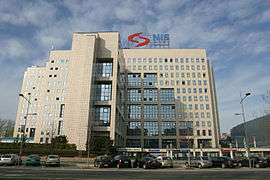
 Iron Gate I power plant
Iron Gate I power plant
Transport
Serbia, and in particular the valley of Morava is often described as "the crossroad between the East and the West". The valley is by far the easiest way of land travel from continental Europe to Greece and Asia Minor.
Serbian road network carries the bulk of traffic in the country. Total length of roads is 40,845 km, of which 1,372 km are "class 1a-state roads" (i.e. major national roads, including some 675 km of motorways); 4,153 km are "class 1b-state roads"; 11,540 km are "class 2-state roads" (regional roads) and 23,780 km are "municipal roads" (local roads).[71][72] The road network, except for the most of class 1a roads, are of comparatively lower quality to the Western European standards because of lack of financial resources for their maintenance in the last 20 years.
There are currently 241 kilometers of motorways (autoputevi) under construction which are all due to be completed by 2017: two sections 40 km-long of the A1 motorway (from south of Leskovac to Bujanovac), 102 km-long segment of A2 (between Obrenovac and Čačak), and 70 kilometers on the A4 (east of Niš to the Bulgarian border).[73] Work on the construction of the remaining part of A2 (52 km-long sections Belgrade-Obrenovac and Čačak-Požega) is set to commence in 2016 and be completed by 2018 and 2019, respectively.[73] Coach transport is very extensive: almost every place in the country is connected by bus, from largest cities to the villages; in addition there are international routes (mainly to countries of Western Europe with large Serb diaspora). Routes, both domestic and international, are served by more than 100 bus companies, biggest of which are Lasta and Niš-Ekspres. As of 2011, there are 1,677,510 registered passenger cars or 1 passenger car per 4.3 inhabitants.[58]
Serbia has 3,819 kilometers of rail tracks, of which 1,279 are electrified and 283 kilometers are double-track railroad.[58] The major rail hub is Belgrade (and to a lesser degree Niš), while the most important railroads include: Belgrade-Bar (Montenegro), Belgrade-Šid-Zagreb (Croatia)/Belgrade-Niš-Sofia (Bulgaria) (part of Pan-European Corridor X), Belgrade-Subotica-Budapest (Hungary) and Niš-Thessaloniki (Greece). Although still a major mode of freight transportation, railroads face increasing problems with the maintenance of the infrastructure and lowering speeds. All rail services are operated by public rail company, Serbian Railways.[74] There are only two cities in Serbia (excluding Kosovo) served by international airports with regular passenger traffic: Belgrade and Niš. Belgrade Nikola Tesla Airport served 4.77 million passengers in 2015, and is a hub of flagship carrier Air Serbia which carried some 2.55 milion passengers in 2015.[75][76] Niš Constantine the Great Airport is mainly catering low-cost airlines.[77]
Serbia has a developed inland water transport since there are 1,716 kilometers of navigable inland waterways (1,043 km of navigable rivers and 673 km of navigable canals), which are almost all located in northern third of the country.[58] The most important inland waterway is the Danube (part of Pan-European Corridor VII). Other navigable rivers include Sava, Tisza, Begej and Timiş River, all of which connect Serbia with Northern and Western Europe through the Rhine–Main–Danube Canal and North Sea route, to Eastern Europe via the Tisza, Begej and Danube Black Sea routes, and to Southern Europe via the Sava river. More than 2.1 million tons of cargo were transported on Serbian rivers and canals in 2011 while the largest river ports are: Belgrade, Novi Sad, Pančevo, Smederevo, Prahovo and Šabac.[58][78]
 A1 motorway near Inđija
A1 motorway near Inđija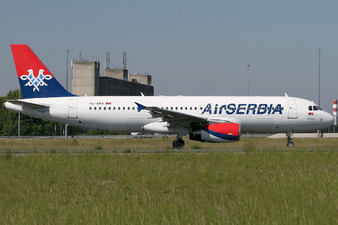 Air Serbia Airbus A320-200
Air Serbia Airbus A320-200- Serbian Railways' FLIRT EMU
Telecommunications

Fixed telephone lines connect 89% of households in Serbia, and with about 9.1 million users the number of cellphones surpasses the total population of Serbia by 29%. The largest mobile operator is Telekom Srbija with 4.2 million subscribers, followed by Telenor with 2.9 million users and Vip mobile with about 2 million.[79] Some 64.7% of households have Internet connection,[80] while practically the same percentage (64.2%) are provided with pay television services (i.e. 37% cable television, 16% IPTV, and 11% satellite).[79] Digital television transition has been completed in 2015 with DVB-T2 standard for signal transmission.[81][82]
Information Technology
The Serbian IT industry is rapidly growing and changing pace. Large investments by global tech companies like Samsung and Microsoft, typical of the last decade, are being eclipsed by a growing number of domestic startups which obtain funding from domestic and international investors. What brought companies like Microsoft in the first place was a large pool of talented engineers and mathematicians in a lower wage country and these major investments had by 2011 generated over €200 million in exports.[83] However, home grown firms were still very small, in 2014, there was a total investment of just US$10 million in all new Serbian tech startups which was a huge rise from less than half a million in 2010.[84] In just the first quarter of 2016, more than US$65 million has been raised by Serbian startups including US$45 million for Seven Bridges (a Bioinformatics firm) and US$14 million for Vast (a data analysis firm).[85][86] Also in 2016, a Belgrade based website AskGamblers which is generating over €810,000 in revenue and €620,000 in profits was sold to Catena Media for €15 million, all 30 employees will continue to work as normal.[87]
Some of the most successful startups have been Nordeus which was founded in Belgrade in 2010. Nordeus is the developer of Top Eleven Football Manager a game played by over 20 million people. Mikroelektronika was founded in 1997 is a successful microelectronics manufacturer with millions of euros in sales. The startup community is helped by a non profit organization called Startit which is an active community that acts as an incubator for new companies. Startit raised US$108,000 from its Kickstarter campaign in 2015, allowing it to expand its Belgrade center and build a second center in Inđija which was completed February 2016.[88] The Serbian tech industry is not limited to Belgrade as several Novi Sad based companies have raised big money including Content Insights which raised €1.1 million and DryTools which recently raised €300,000 from South Central Ventures.[89][90] Also in Novi Sad a company called Alter Ego Architects has developed a 3D Printed cellphone.[91] Other exiting developments include an Agriculture Drone startup that uses drones for land surveying, TeleSkin an app which can identify and track skin cancer and there is an ongoing Kickstarter for Hexiwear a customizable smartwatch for developers.[92] Progress in Serbian IT over the last six years has been tremendous with the fast growth only increasing as Serbia's many talented engineers, scientists and mathematicians break into this new industry where gross salaries average €2,000 per month (far more than the €600 national average).[83]
Tourism
The touristic sector accounted for approximately 6% of GDP in 2015.[93] Tourism in Serbia employs some 75,000 people, about 3% of the country's workforce.[94]
Serbia is not a mass-tourism destination but nevertheless has a diverse range of touristic products.[95] In 2015, total of over 2.4 million tourists were recorded in accommodations, of which some 1.1 million were foreign.[96] Foreign exchange earnings from tourism were estimated at $1.14 billion.[97]
Tourism is mainly focused on the mountains and spas of the country, which are mostly visited by domestic tourists, as well as Belgrade which is preferred choice of foreign tourists.[98] The most famous mountain resorts are Kopaonik, Stara Planina, and Zlatibor. There are also many spas in Serbia, the biggest of which is Vrnjačka Banja, Soko Banja, and Banja Koviljača. City-break and conference tourism is developed in Belgrade (which was visited by 517,401 foreign tourists in 2013, more than a half of all international visits to the country) and to a lesser degree Novi Sad.[99] Other touristic products that Serbia offer are natural wonders like Đavolja varoš,[100] Christian pilgrimage to the many Orthodox monasteries across the country[101] and the river cruising along the Danube. There are several internationally popular music festivals held in Serbia, such as EXIT (with 25–30,000 foreign visitors coming from 60 different countries) and the Guča trumpet festival.[102]
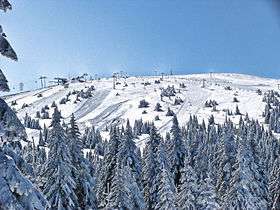 Kopaonik popular tourist destination
Kopaonik popular tourist destination- Banja Koviljača spa resort
National statistics
- External debt (2013)
- Public sector: $16.78 bn
- Private sector: $10.86 bn
- Total: $27.64bn
Source:[103]
- Energy (2014 est.)
Electricity — production: 34.4 billion kWh
Electricity — production by source:
fossil fuels:
59.2%
hydroelectric plants:
40.6%
nuclear fuels:
0% (2013 est.)
other renewable sources:
0.2%
Electricity — consumption: 26.91 billion kWh
Electricity — exports: 4.806 billion kWh
Electricity — imports: 6.864 billion kWh
Crude oil — production: 16,840 barrels per day (2,677 m3/d)
Oil — exports: 0 barrels per day (0 m3/d)
Oil -imports: 31,730 barrels per day (5,045 m3/d)
Oil — proved reserves: 77.5 million barrels (12.32×106 m3) (1 January 2015 est.)
Refined Petroleum products — production: 61,590 barrels per day (9,792 m3/d)
Refined Petroleum products — consumption: 67,980 barrels per day (10,808 m3/d)
Refined Petroleum products — exports: 12,050 barrels per day (1,916 m3/d)
Refined Petroleum products — imports: 20,080 barrels per day (3,192 m3/d)
Natural gas — production: 562.2 million cubic meters
Natural gas — consumption: 2.43 billion cubic meters
Natural gas — exports: 0 cubic meters (2013 est.)
Natural gas — imports: 1.629 billion cubic meters
Natural gas — proved reserves: 48.14 billion cu m (1 January 2014 est.)
Carbon dioxide emissions from consumption of energy: 46 million Mt (2014 est.)
Source:[68]
See also
References
- 1 2 3 4 "Report for Selected Countries and Subjects". International Monetary Fund. Retrieved 13 April 2016.
- ↑ "Statistical Office of the Republic of Serbia". Statistical Office of the Republic of Serbia. Retrieved 30 November 2016.
- 1 2 3 4 5 6 7 8 9 10 11 12 13 14 15 16 17 18 "CIA".
- 1 2 3 "National Bank of Serbia". National Bank of Serbia. Retrieved 2 May 2016.
- 1 2
- ↑ "Ease of Doing Business in Serbia". doingbusiness.org. Retrieved 15 November 2015.
- 1 2 3 4 5 6 7 8 9 Спољнотрговинска робна размена Републике Србије, децембар 2014.. stat.gov.rs (in Serbian). епублички завод за статистику. Retrieved 16 February 2015.
- 1 2 3 "STRONG FDI FIGURES". siepa.gov.rs. Serbia Investment and Export Promotion Agency (SIEPA). Retrieved 3 August 2014.
- ↑
- ↑ "Serbia to get EUR 178.7 million under IPA". b92.net. Retrieved 2 August 2014.
- 1 2 3 4 5
- ↑ "Fitch — Complete Sovereign Rating History". Retrieved 4 August 2014.
- ↑
- ↑ Dobbs, Michael. "NATO's Latest Target: Yugoslavia's Economy". hartford-hwp.com. Washington Post. Retrieved 3 August 2014.
- 1 2 "Report for Selected Countries and Subjects: SERBIA". imf.org. Retrieved October 2015. Check date values in:
|access-date=(help) - ↑ Filipovic, Gordana (10 February 2012). "IMF Sees Serbian 2012 GDP Up 0.5%, Jobless Rate 'a Concern'". Bloomberg.
- ↑ "GDP growth (annual %)". woldbank.org. Retrieved 2 August 2014.
- ↑ Bibić, Bilsana (17 March 2015). "Brain drain in the Western Balkans". opendemocracy.net. Retrieved 29 June 2015.
- ↑ "ODLIV MOZGOVA Srbiju godišnje napusti 32.000 ljudi". blic.rs (in Serbian). RTS. 7 December 2014. Retrieved 29 June 2015.
- ↑ K., E. "DIJASPORA POMAŽE SRBIJU: Od doznaka 5,5 milijardi dolara". kurir-info.rs (in Serbian). Retrieved 2 August 2014.
- 1 2 "Success Stories". siepa.gov.rs. Archived from the original on March 7, 2010. Retrieved 2 August 2014.
- 1 2 "12-year FDI inflow worth EUR 16bn; Italy tops list". b92.net. Tanjug. Retrieved 2 August 2014.
- ↑ "INVESTING IN SERBIA 2013" (pdf). siepa.gov.rs. Serbia Investment and Export Promotion Agency. Retrieved 2 August 2014.
- ↑ "Report for Selected Countries and Subjects: Serbia". imf.org. Retrieved 5 April 2015.
- ↑ "Agriculture represents almost one fourth of Serbia's total exports". balkans.com. Retrieved 2 August 2014.
- ↑ "Industrial production indices by sectors". stat.gov.rs. Archived from the original on November 13, 2010. Retrieved 2 August 2014.
- ↑ "Електронска библиотека: претрага". stat.gov.rs. Retrieved 3 August 2014.
- ↑ "Macroeconomic Data" (PDF). javnidug.gov.rs (in Serbian). Retrieved 2 May 2014.
- 1 2 3 4 "LIBERALIZED TRADE". siepa.gov.rs. Archived from the original on April 29, 2012. Retrieved 3 August 2014.
- ↑ "Top Trading Partners — Trade Statistics" (PDF). europa.eu. European Commission. Retrieved 3 August 2014.
- ↑ "Robna razmena između Srbije i Nemačke dostigla rekord u 2013.". plutonlogistics.com (in Serbian). Republički zavod za statistiku. Retrieved 3 August 2014.
- 1 2 "SERBIA" (PDF). mtt.gov.rs. Ministry of Foreign and Internal Trade and Telecommunications. Retrieved 3 August 2014.
- ↑ "Potpisan sporazum sa zemljama EFTA". b92.net (in Serbian). Fonet. Retrieved 3 August 2014.
- ↑ "America Open for Trade, Serbia for Investments" (PDF). promoney.rs. Ministry of Economy of Serbia. Retrieved 3 August 2014.
- ↑ "Investment Incentives". siepa.gov.rs. Archived from the original on June 18, 2012. Retrieved 3 August 2014.
- ↑ "Serbia ranked first in investors' poll". emportal.co.rs. Archived from the original on February 20, 2012. Retrieved 3 August 2014.
- ↑ "Why Invest: Serbia". doingbusinessinserbia.com. Retrieved 3 August 2014.
- ↑ "List of Banks". nbs.rs. Retrieved 3 August 2014.
- ↑ "Citibank to open office in Serbia".
- ↑ "Serbia to get first IT park". aljazeera.com. Retrieved 3 August 2014.
- ↑ "Embassy Group Will Build $390 Million-Euro IT Park in Serbia". bloomberg.com. Retrieved 3 August 2014.
- ↑ СТО НАЈ... ПРИВРЕДНИХ ДРУШТАВА У РЕПУБЛИЦИ СРБИЈИ У 2013. ГОДИНИ (PDF). apr.gov.rs (in Serbian). Агенција за привредне регистре. Retrieved 31 July 2014.
- ↑ "Подаци о обвезнику: Naftna Industrija Srbije". apr.gov.rs (in Serbian). Агенција за привредне регистре. Retrieved 31 July 2014.
- ↑ "Подаци о обвезнику: Elektroprivreda Srbije". apr.gov.rs (in Serbian). Агенција за привредне регистре. Retrieved 31 July 2014.
- ↑ "Подаци о обвезнику: Fiat Automobili Srbija". apr.gov.rs (in Serbian). Агенција за привредне регистре. Retrieved 31 July 2014.
- ↑ "Подаци о обвезнику: Telekom Srbija". apr.gov.rs (in Serbian). Агенција за привредне регистре. Retrieved 31 July 2014.
- ↑ "Подаци о обвезнику: Delhaize Serbia". apr.gov.rs (in Serbian). Агенција за привредне регистре. Retrieved 31 July 2014.
- ↑ "Подаци о обвезнику: Srbijagas". apr.gov.rs (in Serbian). Агенција за привредне регистре. Retrieved 31 July 2014.
- ↑ "Подаци о обвезнику: Tarkett". apr.gov.rs (in Serbian). Агенција за привредне регистре. Retrieved 31 July 2014.
- ↑ "Подаци о обвезнику: Mercator-S". apr.gov.rs (in Serbian). Агенција за привредне регистре. Retrieved 31 July 2014.
- ↑ "Подаци о обвезнику: IDEA". apr.gov.rs (in Serbian). Агенција за привредне регистре. Retrieved 31 July 2014.
- ↑ "Подаци о обвезнику: Delta Holding". apr.gov.rs (in Serbian). Агенција за привредне регистре. Retrieved 31 July 2014.
- ↑ "Serbia's agricultural potential — EUR 12 billion". B92. 15 March 2013. Retrieved 14 June 2013.
- 1 2 "Privreda u Srbiji". Retrieved 27 October 2014.
- ↑ "RTS". Retrieved 27 October 2014.
- ↑ "Food". Retrieved 27 October 2014.
- 1 2 "Agriculture". Government of Serbia. Archived from the original on 16 June 2013. Retrieved 19 March 2013.
- 1 2 3 4 5 6 http://pod2.stat.gov.rs/ObjavljenePublikacije/G2012/pdf/G20122007.pdf
- ↑ "Serbia Overview". Food and Agriculture Organization of the United Nations. Retrieved 14 June 2013.
- ↑ "About Us". eps.rs. Retrieved 3 August 2014.
- ↑ "EPS". Energy Fundamentals. Retrieved 15 June 2013.
- ↑ "Cooperation of Vojvodina and NIS in the field of geothermal energy". vibilia.rs. Retrieved 3 August 2014.
- ↑ "Serbia's NIS to expand in four E. European states". Reuters. 2 September 2011.
- ↑ "NIS plans to invest into Romania several hundred million euros". vibilia.rs. Retrieved 3 August 2014.
- ↑ "NIS and RAGF signed an Agreement on Exploration in Hungary". vibilia.rs. Retrieved 3 August 2014.
- ↑ "Transport prirodnog gasa". srbijagas.com (in Serbian). Retrieved 3 August 2014.
- ↑ "Electric Power Industry of Serbia" (PDF). reneuer.com. Archived from the original (pdf) on November 5, 2010. Retrieved 3 August 2014.
- 1 2 "Energy::SERBIA". cia.gov. Central Intelligence Agency. Retrieved 19 March 2016.
- ↑ "Energy: Serbia's renewables growth aims to outstrip EU". ft.com. Financial Times. Retrieved 3 August 2014.
- ↑ "Serbia's 2020 Energy-Mix Target to Set Renewables at 27 Percent". bloomberg.com. Retrieved 3 August 2014.
- ↑ http://www.putevi-srbije.rs/pdf/zakon_o_putevima_lat.pdf
- ↑ http://www.putevi-srbije.rs/sr/putna-mrea-republike-srbije Archived 17 December 2011 at the Wayback Machine.
- 1 2 http://www.blic.rs/vesti/ekonomija/mihajlovic-na-putevima-i-prugama-srbije-radovi-vredni-45-milijarde-evra/zdvdn6x
- ↑ "General Information". Serbian Railways.
- ↑ http://www.beg.aero/en/strana/11161/%D0%A1%D1%82%D0%B0%D1%82%D0%B8%D1%81%D1%82%D0%B8%D0%BA%D0%B0
- ↑ http://www.ekapija.com/website/en/page/1370228/Air-Serbia-registers-2-55-million-passengers-in-2015
- ↑ "Niš Airport to expand". EX-YU Aviation News. 25 July 2015.
- ↑ "Investing in Serbia: Modern Infrastructure, Transport". SIEPA. Archived from the original on 6 November 2009. Retrieved 28 April 2010.
- 1 2 http://ratel.rs/upload/documents/Pregled_trzista/RATEL%20-%20Pregled%20trzista%20u%202015.pdf
- ↑ http://webrzs.stat.gov.rs/WebSite/repository/documents/00/02/25/86/IKT__2016_pres_s.pdf
- ↑
- ↑ http://www.etv.rs/etvesti/87-etvakcije/281-zavrsena-digitalizacija
- 1 2
- ↑ "Koliko su zapravo investicija uzeli srpski startapi — 0, 200.000, 6 ili 10+ miliona, i koliko je to uopšte bitno? - startit". startit.rs. Retrieved 2016-11-03.
- ↑ "Srpsko-američki Seven Bridges uzeo investiciju od 45 miliona dolara za brži razvoj lečenja raka — startit". startit.rs. Retrieved 2016-11-03.
- ↑ "Vast uzeo investiciju od 14 miliona dolara za razvoj B2C proizvoda i širenje u Beogradu — startit". startit.rs. Retrieved 2016-11-03.
- ↑
- ↑ "Startit Centar". startit. Retrieved 2016-11-03.
- ↑ "Novosadski dryTools uzeo 300.000€ investiciju za proizvod koji ubrzava programere — startit". startit.rs. Retrieved 2016-11-03.
- ↑ "Najveća investicija do sada u Novom Sadu — Content Insights uzeo 1.1 milion evra za budućnost novinarstva — startit". startit.rs. Retrieved 2016-11-03.
- ↑ "Novosadski OPhone — lepi glupi telefon za one koji žele da pobegnu od notifikacija — startit". startit.rs. Retrieved 2016-11-03.
- ↑ "Srpski AgroDrone razvija poljoprivredu budućnosti — startit". startit.rs. Retrieved 2016-11-03.
- ↑ "Cilj države da turizam čini 9% BDP-a — U prva četiri meseca 2016. u Srbiji oko 300.000 stranih turista". Retrieved 2016-11-03.
- ↑ Serbia, in: Alain Dupeyras (ed.) (2012). OECD tourism trends and policies 2012. Paris: Organization for Economic Cooperation & Development. ISBN 9789264177567. p. 403–407.doi:10.1787/tour-2012-56-en
- ↑ "Serbia Times Daily News – Dacic: Tourism records positive growth rates". Serbia-times.com. 28 May 2013.
- ↑ http://webrzs.stat.gov.rs/WebSite/repository/documents/00/01/88/89/16_TOURISM_AND_CATERING_TRADE.pdf
- ↑ http://bif.rs/2016/08/devizni-priliv-od-turizma-milijardu-evra/
- ↑ "Serbia". au.totaltravel.yahoo.com. Retrieved 20 March 2013.
- ↑ "Putovanja – Porast broja turista u Beogradu u 2013. – B92 Putovanja". B92. Retrieved 27 October 2014.
- ↑ "Đavolja varoš". serbia.travel. Retrieved 20 March 2013.
- ↑ "Pilgrimage of Saint Sava". Info Hub.
- ↑ "Kultura – Vesti – Na Exitu oko 25 hiljada stranaca". B92.
- ↑ "ANALYSIS OF THE REPUBLIC OF SERBIA'S DEBT" (pdf). nbs.rs. National Bank of Serbia. p. 8. Retrieved 3 August 2014.
Further reading
- Martinez, Jose de Luna; Endo, Isaku; Barberis, Corrado (2006). The Germany-Serbia Remittance Corridor: Challenges of Establishing a Formal Money Transfer System. Washington, D.C.: World Bank Publications. ISBN 978-0-8213-6659-2.
External links
| Wikimedia Commons has media related to Economy of Serbia. |
- Serbia Investment and Export Promotion Agency
- Serbian Chamber of Commerce
- National Bank of Serbia
- Belgrade Stock Exchange

